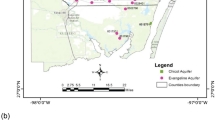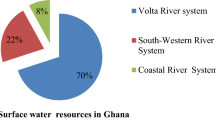Abstract
Freshwater discharge into the coastal sea is of general interest for two reasons: (i) It acts as vehicle for the transport of contaminants or nutrients into the ocean, and (ii) it indicates the loss of significant volumes of freshwater that might be needed for irrigation or drinking water supply. Due to the large-scale and long-term nature of the related hydrological processes, locating and quantitatively assessing freshwater discharge into the sea require naturally occurring tracers that allow fast, inexpensive and straightforward detection. In several studies, the standard water parameters electrical conductivity (EC) and pH have proven their suitability in this regard. However, while distribution patterns of EC and pH in the coastal sea indicate freshwater discharge in general, a separation between discharging surface water and submarine groundwater discharge (SGD) is not possible with these alone. The naturally occurring radionuclide radon-222 has been shown to be useful in the quantification of SGD and its distinction from surface runoff. This study aimed to evaluate and compare the informative value of the three parameters—EC, pH and radon concentration—in detecting and quantifying SGD by carrying out a case study in a bay located in western Ireland. The results reveal that radon activity is the most sensitive parameter for detecting SGD. However, only the combined evaluation of radon, EC and pH allows a quantitative allocation of groundwater and surface water contributions to the overall freshwater discharge into the sea. This conclusion is independently supported by stable isotope data measured on selected samples.





Similar content being viewed by others
References
Bowen, R. (1973). Geohydrologic study of the Gort Lowland and adjacent areas of western Ireland using environmental isotopes. Water Resources Research, 9(3), 753–758.
Burnett, W. C., & Dulaiova, H. (2003). Estimating the dynamics of groundwater input into the coastal zone via continuous radon-222 measurements. Journal of Environmental Radioactivity, 69, 21–35.
Cable, J. E., Burnett, W. C., Chanton, J. P., & Weatherly, G. L. (1996). Estimating groundwater discharge into the north-eastern Gulf of Mexico using radon-222. Earth and Planetary Science Letters, 144, 591–604.
Cave, R. R., & Henry, T. (2011). Intertidal and submarine groundwater discharge on the west coast of Ireland. Estuarine, Coastal and Shelf Science. doi:10.1016/j.ecss.2011.01.019.
Cook, P. G., Wood, C., White, T., Simmons, C. T., Fass, T., & Brunner, P. (2008). Groundwater inflow to a shallow poorly-mixed wetland estimated from a mass balance of radon. Journal of Hydrology, 354, 213–226.
Corbett, D. R., Burnett, W. C., Cable, P. H., & Clark, S. B. (1998). A multiple approach to the determination of radon fluxes from sediments. Journal of Radioanalytical and Nuclear Chemistry, 236, 247–252.
Coxon, C. E. (1987). The spatial distribution of turloughs. Irish Geography, 20, 11–23.
Coxon, C.E. & Drew, D.P. (2000). Interdependence of groundwater and surface water in lowland karst areas of western Ireland: management issues arising from water and contaminant transfers. In: N.S. Robins & Misstear, B. (Eds), Groundwater in the Celtic Regions: studies in hard rock and quaternary hydrogeology (pp. 81–88). Geological Society, London, Special Publications 182.
Drew, D. (1990). The hydrology of the Burren, County Clare. Irish Geography, 23, 69–89.
Drew, D. (1992). Water resource management and water tracing in a lowland karst aquifer, Western Ireland. In H. Hoetzl & A. Werner (Eds.), Tracer hydrology (pp. 221–225). Leiden: Balkema.
Drew, D. (2008). Hydrogeology of lowland karst in Ireland. Quarterly Journal of Engineering Geology and Hydrogeology, 41, 61–72.
Drew, D.P. & Daly, D. (1993). Groundwater and karstification in mid-Galway, South Mayo and North Clare—a joint report: Department of Geography, Trinity College Dublin and Groundwater Section, Geological Survey of Ireland. Geological Survey of Ireland Report Series 93/3 (Groundwater).
Drew, D. P., Doerfliger, N., & Formentin, K. (1997). The use of bacteriophages for multi-tracing in a lowland karst aquifer in western Ireland. In A. Kranjc (Ed.), Tracer hydrology (pp. 33–38). Rotterdam: Balkema.
Einsiedl, F., Maloszewski, P., & Stichler, W. (2005). Estimation of denitrification potential in a karst aquifer using the 15N and 18O isotopes of nitrate. Biogeochemistry, 72, 67–86.
Einsiedl, F., Maloszewski, P., & Stichler, W. (2009). Multiple isotope approach to the determination of the natural attenuation potential of a high-alpine karst system. Journal of Hydrology, 365, 113–121.
Gill, L. W., Naughton, O., Johnston, P. M., Basu, B., & Ghosh, B. (2013). Characterisation of hydrogeological connections in a lowland karst network using time series analysis of water levels in ephemeral groundwater-fed lakes (turloughs). Journal of Hydrology, 499, 289–302.
Hu, C., Muller-Karges, F. E., & Swarzenski, P. W. (2006). Hurricanes, submarine groundwater discharge and Florida’s red tides. Geophysical Research Letters. doi:10.1029/2005GL025449.
Hwang, D. W., Kim, G., Lee, Y. W., & Yang, H. S. (2005). Estimating submarine inputs of groundwater and nutrients to a coastal bay using radium isotopes. Marine Chemistry, 96, 61–71.
Keulegan, G.H. (1967). Tidal Flow in Entrances. U.S. Army Corps of Engineers, Committee on Tidal Hydraulics, Tech. Bull. 14.
Laroche, J., Nuzzi, R., Waters, R., Wyman, K., Falkowski, P., & Wallace, D. (1997). Brown Tide blooms in Long Island's coastal waters linked to interannual variability in groundwater flow. Global Change Biology, 3(5), 397–410.
Lee, D. R. (1977). A device for measuring seepage flux in lakes and estuaries. Limnology and Oceanography, 22, 140–147.
Moore, W. S. (1996). Large groundwater inputs to coastal waters revealed by 226Ra enrichments. Nature, 380, 612–614.
Moore, W. S., Sarmiento, J. L., & Key, R. M. (2008). Submarine groundwater discharge revealed by 228Ra distribution in the upper Atlantic Ocean. Nature Geoscience, 1, 309–311.
Nazaroff, W. W., Moed, B. A., & Sextro, R. G. (1988). Soil as a source of indoor radon: Generation, migration, and entry. In W. W. Nazaroff & A. V. Nero Jr. (Eds.), Radon and its decay products in indoor air (pp. 57–112). Hoboken: John.
Oliveira, J., Burnett, W. C., Mazilli, B. P., Braga, E. S., Farias, L. A., Christoff, J., & Furtado, V. V. (2003). Reconnaissance of submarine groundwater discharge at Ubatuba coast, Brazil, using 222Rn as a natural tracer. Journal of Environmental Radioactivity, 69, 37–52.
Peterson, R. N., Burnett, W. C., Taniguchi, M., Chen, J., Santos, I. R., & Ishitobi, T. (2008). Radon and radium isotope assessment of submarine groundwater discharge in the Yellow River Delta, China. Journal of Geophysical Research. doi:10.1029/2008JC004776.
Santos, I. R., Niencheski, F., Burnett, W. C., Peterson, R., Chanton, J., Andrade, C. F., Milani, I. B., Schmidt, A., & Knöller, K. (2008). Tracing anthropogenically-driven groundwater discharge into a coastal lagoon from southern Brazil. Journal of Hydrology, 353, 275–293.
Schachtschabel, P., Blume, H.P., Brümmer, G., Hartge, K.H., Schwertmann, U. (Eds.) (1989). Lehrbuch der Bodenkunde (pp. 146–150). Stuttgart: Enke.
Schmidt, A., Schlüter, M., Melles, M., & Schubert, M. (2008). Continuous and discrete on-site detection of radon-222 in ground- and surface waters by means of an extraction module. Applied Radiation and Isotopes, 66, 1939–1944.
Schubert, M., Buerkin, W., Peña, P., Lopez, A., & Balcázar, M. (2006). On-site determination of the radon concentration in water samples: methodical background and results from laboratory studies and a field-scale test. Radiation Measurements, 41, 492–497.
Schubert, M., Schmidt, A., Lopez, A., Balcázar, M., & Paschke, A. (2008). In-situ determination of radon in surface water bodies by means of a hydrophobic membrane tubing. Radiation Measurements, 43, 111–120.
Stieglitz, T. (2005). Submarine groundwater discharge into the near-shore zone of the Great Barrier Reef, Australia. Marine Pollution Bulletin, 51, 51–59.
Stieglitz, T., Rapaglia, J. P., & Krupa, S. (2007). An effect of pier pilings on nearshore submarine groundwater discharge from a (partially) confined aquifer. Estuaries and Coasts, 30(3), 543–550.
Stringer, C., & Burnett, W. C. (2004). Sample bottle design improvements for radon emanation analysis of natural waters. Health Physics, 87, 642–646.
Taniguchi, M., Burnett, W. C., Cable, J. E., & Turner, J. V. (2002). Investigation of submarine groundwater discharge. Hydrological Processes, 16, 2115–2129.
Taniguchi, M., Burnett, W. C., Dulaiova, H., Kontar, E. A., Povinec, P. P., & Moore, W. S. (2006). Submarine groundwater discharge measured by seepage meters in Sicilian coastal waters. Continental Shelf Research, 26(7), 835–842.
Williams, P. W. (1970). Limestone morphology in Ireland. In N. Stephens & R. E. Glasscock (Eds.), Irish geographical studies (pp. 105–124). Belfast: Queens University.
Acknowledgments
The authors want to thank Reiner Stollberg (Martin Luther University of Halle, Germany) for digital elevation model analyses, Isaac Santos (Southern Cross University, Lismore, Australia) for discussion of oceanographic issues, Jean Wilson (BRG, Trinity College Dublin) for calculation of submerged areas at different tidal stages by remote sensing, and Rachel Cave, Tiernan Henry, and Shane Rooney (National University of Ireland, Galway) for assistance and technical support. Funding for this project was provided by the NUI Galway Griffith Geoscience award that was based on research grant aided by the Department of Communications, Energy and Natural Resources under the National Geoscience Programme 2007–2013.
Author information
Authors and Affiliations
Corresponding author
Rights and permissions
About this article
Cite this article
Schubert, M., Knoeller, K., Rocha, C. et al. Evaluation and source attribution of freshwater contributions to Kinvarra Bay, Ireland, using 222Rn, EC and stable isotopes as natural indicators. Environ Monit Assess 187, 105 (2015). https://doi.org/10.1007/s10661-015-4274-3
Received:
Accepted:
Published:
DOI: https://doi.org/10.1007/s10661-015-4274-3




